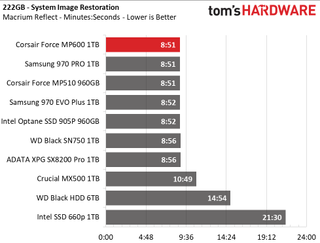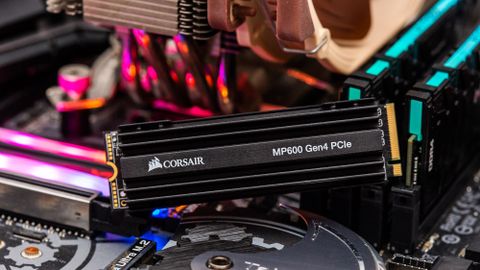Why you can trust Tom's Hardware
Comparison Products
Today, we're comparing Corsair’s MP600 to some of the best SSDs available. First up is the Intel Optane 905P. With its 3D XPoint memory, it puts flash to shame with ultra-low response times but costs more than any other consumer SSD. We also threw in both Samsung’s 970 PRO (Phoenix + 64L MLC V-NAND) and 970 EVO Plus (Phoenix + 9xL TLC V-NAND) as high-end contenders. Following these, we added in the WD Black SN750 (in-house NVMe controller + Kioxia 64L TLC), the Adata XPG SX8200 Pro (SM2262EN + Micron 64L TLC), and a Corsair Force MP510 (Phison E12 + Kioxia 64L TLC). We also included one of the cheapest NVMe SSDs, the Intel SSD 660p (SM2263EN + Micron 64L QLC), as well as Crucial’s MX500 (SM2258 + Micron 64L TLC), a SATA SSD. Finally, we added in a 6TB WD Black, a 7200 RPM HDD for extra context.
Game Scene Loading - Final Fantasy XIV
The Final Fantasy XIV StormBlood benchmark is a free real-world game benchmark that easily and accurately compares game load times without the inaccuracy of using a stopwatch.

As we saw with our engineering sample before, games aren’t going to load any faster with the new interface. The MP600 scores a total load time of 11.45 seconds, an average score that lands it fifth place overall. While not much different than other NVMe SSDs, it is more than twice as fast as the HDD.
System Restore – Macrium Reflect
A system clone or restoration isn’t something many people do often. But it can become a time-consuming task with slow storage devices like HDDs or entry-level SSDs - especially if you have a lot of data. Therefore, we developed a test to measure how long this task takes. To ensure repeatable results, we secure erase each SSD to ensure the pSLC cache is empty before we restore an average-sized 222GB operating system and files from a 1.5TB Intel Optane SSD 905P.

System image restoration goes off without a hitch. Our restore operation is mostly limited by the software rather than device throughput. But, still, the Intel 660p’s smaller cache paired with slow direct to QLC write speeds caused for a much longer restoration time. Corsair ranks first overall, with a restoration time of 8 minutes and 31 seconds.
Transfer Rates – DiskBench
We use the DiskBench storage benchmarking tool to test file transfer performance with our own custom 50GB block of data. Our data set includes 31,227 files of various types, like pictures, PDFs, and videos. We copy the files to a new folder and then follow up with a reading test of a newly-written 6.5 GB file.


File copy performance is up there with the best. With a lot of small files included in our test folders, the MP600 wasn’t as fast as Intel's Optane 905P, since it’s 4K random read performance is so much better than any flash-based competitor. But being slower by just 25 MBps on average, the MP600 ranks second overall. During the file read back test, however, the MP600 easily scored first place with a speed of 2,875 MBps, a 13x improvement over the HDD.
Trace Testing – PCMark 8 Storage Test 2.0
PCMark 8 is a trace-based benchmark that uses Microsoft Office, Adobe Creative Suite, World of Warcraft, and Battlefield 3 to measure the performance of storage devices in real-world scenarios.


In application testing, Intel’s Optane 905P scored first place again and Samsung’s 970 PRO scored second. Corsair’s MP600 scored third, just a point below the 970 PRO and an average in bandwidth just 15 MBps behind. This is a fantastic jump from the previous generation Corsair Force MP510, which landed sixth place with an average bandwidth of just 585 MBps.
Trace Testing – SPECworkstation 3
Like PCMark 8, SPECworkstation 3 is a trace-based benchmark, but it is designed to push the system harder by measuring workstation performance in professional applications. The full suite consists of more than 30 workloads, but we've opted to only run the storage benchmark which uses only 15 of them and categorizes the results into 5 market segments for scoring: Media & Entertainment, Product Development, Life Sciences, Energy, and General Operations.







When working with professional software, Intel’s Optane 905P is the way to go if you are looking for the best performance, but the MP600 isn’t too far behind. With a final score of 4.66 and completion time of just over 25 minutes, it gains a win over the Samsung 970 PRO and proves to be a worthy choice for most prosumers looking for a drive that can keep up with their workflow.
Synthetic Testing - ATTO
ATTO is a simple and free application that SSD vendors commonly use to assign sequential performance specifications to their products. It also gives us insight into how the device handles different file sizes. We test at a QD of 1, which better represents consumer performance, instead of the default value of 4.


In ATTO, the Force MP600 outperforms every other drive from the 16KB file size and up. Even at the lowest QD of 1, it is capable of sequential performance that hits 4.8 /3.9 GBps read/write.
Synthetic Testing - iometer
iometer is an advanced and highly configurable storage benchmarking tool that vendors often use to measure the performance of their devices.














In iometer, Corsair’s Force MP600 shows off 5/4.3 GBps read/write results. This is a big improvement over any PCIe 3.0 SSD and gives it first place in sequential performance.
Random performance is also very good. Peak performance numbers earn it the first place rank with results of 600,000/540,000 IOPS read/write. At QD1-4 the MP600 scores similarly to the 970 PRO.
Sustained Sequential Write Performance
Official write specifications are only part of the performance picture. Most SSD makers implement a pseudo-SLC cache buffer, which is a fast area of SLC-programmed flash that absorbs incoming data. Sustained write speeds can suffer tremendously once the workload spills outside of the pSLC cache and into the "native" TLC or QLC flash. We use iometer to hammer the SSD with sequential writes for 15 minutes to measure both the size of the pSLC buffer and performance after the buffer is saturated.


With its high-speed performance, the Corsair Force MP600 has a large write cache to go along with it. While the SLC cache is officially rated to be 333GB from Phison, the Force MP600 was able to sustain over 370GB of writes at a pace of just under 4.3 GBps before performance declined. Once the cache was full, write speeds dropped to about 600 MBps on average.
Power Consumption
We use the Quarch HD Programmable Power Module to gain a deeper understanding of power characteristics. Idle power consumption is a very important aspect to consider, especially if you're looking for a new drive for your laptop. Some SSDs can consume watts of power at idle while better-suited ones sip just milliwatts. Average workload power consumption and max consumption are two other aspects of power consumption, but performance-per-watt is more important. A drive might consume more power during any given workload, but accomplishing a task faster allows the drive to drop into an idle state faster, which ultimately saves power.





Power consumption is very similar to other NVMe SSDs. On average the Corsair drive drew 3.95W during the 50GB transfer test and peaked at 6.43W. But, once combined with its speed, it outranks and is more efficient than every other SSD we've tested. Even at idle, it draws only 64mW when ASPM is enabled and 1.2W when not.
MORE: Best SSDs
MORE: How We Test HDDs And SSDs
MORE: All SSD Content

Sean is a Contributing Editor at Tom’s Hardware US, covering storage hardware.
-
dan_L I'm kind of wondering why the article didn't include the most comparable NVMe drive, the Gigabyte Aorus? It would seem to make sense to see how the two compare.Reply
I got the 1 TB Aorus a few weeks ago and it does, indeed, top 5,000 MBps sequential reads and close to 5,000 for sequential writes (using CrystalMark). I can report that this speed definitely makes one's computer a lot peppier than, say, the Samsung 970 EVO it replaced, espepcially when doing intensive desktop publishing and copying files of just about any size. The price of the Aorus does come down to $210 at Micro Center and newegg.com from time to time. -
seanwebster Reply
I do not have access to one. Besides, its the same exact drive with a different heatsink. The performance is the same.dan_L said:I'm kind of wondering why the article didn't include the most comparable NVMe drive, the Gigabyte Aorus? It would seem to make sense to see how the two compare.
I got the 1 TB Aorus a few weeks ago and it does, indeed, top 5,000 MBps sequential reads and close to 5,000 for sequential writes (using CrystalMark). I can report that this speed definitely makes one's computer a lot peppier than, say, the Samsung 970 EVO it replaced, espepcially when doing intensive desktop publishing and copying files of just about any size. The price of the Aorus does come down to $210 at Micro Center and newegg.com from time to time. -
mrnelson Since we’re all so interested in NVMe speeds with Ryzen 3000, could you publish a few benchmarks with these drives running in a dual RAID 0 configuration? I‘m really curious how AMD’s implementation performs as I’m only familiar with Intel’s RST (this is in light of so many X570 motherboards having at least two M.2 slots).Reply
Given the disparate pricing/sizing/performance of available NVMe drives, there may be low price performance sweet spots going two smaller/cheaper drives in RAID 0, no? -
supremelaw Is Intel planning to make Optane drives that also use PCIe 4.0 bandwidth?Reply
I like the idea of "syncing" chipset speeds with drive interface speeds.
Storage manufacturers should be embracing PCIe 4.0 with more options.
And, NVMe should support all modern RAID modes, in the same way
that integrated SATA ports eventually came with "native" RAID support.
EDIT: just saw this review:
https://www.tomshardware.com/news/lexars-new-nvme-ssd-hits-7gbps-the-fastest-yet-for-a-pcie-40-ssd -
pdegan2814 I ended up getting one of these drives for my most recent PC build, a Ryzen 3xxx system. The performance is definitely there but what sold me was the endurance rating. Honestly, a simple SATA ssd is probably "enough" performance for my needs, what I want is a drive that'll last.Reply
